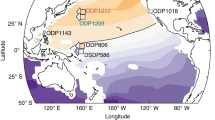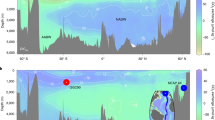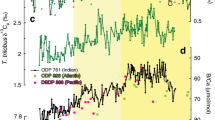Abstract
Ocean circulation critically affects the global climate and atmospheric carbon dioxide through redistribution of heat and carbon in the Earth system. Despite intensive research, the nature of past ocean circulation changes remains elusive. Here we present deep-water carbonate ion concentration reconstructions for widely distributed locations in the Atlantic Ocean, where low carbonate ion concentrations indicate carbon-rich waters. These data show a low-carbonate-ion water mass that extended northward up to about 20° S in the South Atlantic at 3–4 km depth during the Last Glacial Maximum. In combination with radiocarbon ages, neodymium isotopes and carbon isotopes, we conclude that this low-carbonate-ion signal reflects a widespread expansion of carbon-rich Pacific deep waters into the South Atlantic, revealing a glacial deep Atlantic circulation scheme different than commonly considered. Comparison of high-resolution carbonate ion records from different water depths in the South Atlantic indicates that this Pacific deep-water expansion developed from approximately 38,000 to 28,000 years ago. We infer that its associated carbon sequestration may have contributed critically to the contemporaneous decline in atmospheric carbon dioxide, thereby helping to initiate the glacial maximum.
This is a preview of subscription content, access via your institution
Access options
Access Nature and 54 other Nature Portfolio journals
Get Nature+, our best-value online-access subscription
$29.99 / 30 days
cancel any time
Subscribe to this journal
Receive 12 print issues and online access
$259.00 per year
only $21.58 per issue
Buy this article
- Purchase on Springer Link
- Instant access to full article PDF
Prices may be subject to local taxes which are calculated during checkout




Similar content being viewed by others
Data availability
We have chosen not to deposit the data at this time but declare that all data presented in this study are provided in the Supplementary Tables.
References
Oppo, D. et al. Data constraints on glacial Atlantic water mass geometry and properties. Paleoceanogr. Paleoclimatol. 33, 1013–1034 (2018).
Lynch-Stieglitz, J. et al. Atlantic meridional overturning circulation during the Last Glacial Maximum. Science 316, 66–69 (2007).
Howe, J. N. W. et al. North Atlantic Deep Water production during the Last Glacial Maximum. Nat. Commun. 7, 11765 (2016).
Gebbie, G. How much did Glacial North Atlantic Water shoal? Paleoceanogr. Paleoclimatol. 29, 190–209 (2014).
Skinner, L., Fallon, S. J., Waelbroeck, C., Michel, E. & Barker, S. Ventilation of the deep Southern Ocean and deglacial CO2 rise. Science 328, 1147–1151 (2010).
Piotrowski, A. et al. Reconstructing deglacial North and South Atlantic deep water sourcing using foraminiferal Nd isotopes. Earth Planet. Sci. Lett. 357–358, 289–297 (2012).
Burke, A. et al. The glacial mid-depth radiocarbon bulge and its implications for the overturning circulation. Paleoceanogr. Paleoclimatol. 30, 1021–1039 (2015).
Robinson, L. F. & van de Flierdt, T. Southern Ocean evidence for reduced export of North Atlantic Deep Water during Heinrich event 1. Geology 37, 195–198 (2009).
Anderson, R. F. et al. Deep-sea oxygen depletion and ocean carbon sequestration during the last ice age. Glob. Biogeochem. Cycles 33, 301–317 (2019).
Jaccard, S. L. & Galbraith, E. D. Large climate-driven changes of oceanic oxygen concentrations during the last deglaciation. Nat. Geosci. 5, 151–156 (2012).
Key, R. M. et al. A global ocean carbon climatology: results from Global Data Analysis Project (GLODAP). Glob. Biogeochem. Cycles 18, GB4031 (2004).
Yu, J. et al. Sequestration of carbon in the deep Atlantic during the last glaciation. Nat. Geosci. 9, 319–324 (2016).
Burke, A. & Robinson, L. F. The Southern Ocean’s role in carbon exchange during the last deglaciation. Science 335, 557–561 (2012).
Skinner, L. C. et al. North Atlantic versus Southern Ocean contributions to a deglacial surge in deep ocean ventilation. Geology 41, 667–670 (2013).
Barker, S., Knorr, G., Vautravers, M., Diz, P. & Skinner, L. Extreme deepening of the Atlantic overturning circulation during deglaciation. Nat. Geosci. 3, 567–571 (2010).
Adkins, J. F., McIntyre, K. & Schrag, D. P. The salinity, temperature, and δ18O of the glacial deep ocean. Science 298, 1769–1773 (2002).
Yu, J. M. & Elderfield, H. Benthic foraminiferal B/Ca ratios reflect deep water carbonate saturation state. Earth Planet. Sci. Lett. 258, 73–86 (2007).
Yu, J. et al. Loss of carbon from the deep sea since the Last Glacial Maximum. Science 330, 1084–1087 (2010).
Marchitto, T. & Broeker, W. Deep water mass geometry in the glacial Atlantic Ocean: a review of constraints from the paleonutrient proxy Cd/Ca. Geochem. Geophys. Geosyst. 7, (2006).
Yu, J. More efficient North Atlantic carbon pump during the Last Glacial Maximum. Nat. Commun. 10, 2170 (2019).
Chalk, T. B., Foster, G. L. & Wilson, P. A. Dynamic storage of glacial CO2 in the Atlantic Ocean revealed by boron [CO3 2−] and pH records. Earth Planet. Sci. Lett. 510, 1–11 (2019).
Broecker, W., Yu, J. & Putnam, A. E. Two contributors to the glacial CO2 decline. Earth Planet. Sci. Lett. 429, 191–196 (2015).
Yu, J. M., Elderfield, H. & Piotrowski, A. Seawater carbonate ion–δ13C systematics and application to glacial–interglacial North Atlantic Ocean circulation. Earth Planet. Sci. Lett. 271, 209–220 (2008).
Menviel, L. et al. Poorly ventilated deep ocean at the Last Glacial Maximum inferred from carbon isotopes: a data-model comparison study. Paleoceanogr. Paleoclimatol. 31, 2–17 (2017).
Muglia, J., Skinner, L. & Schmittner, A. Weak overturning circulation and high Southern Ocean nutrient utilization maximized glacial ocean carbon. Earth Planet. Sci. Lett. 496, 47–56 (2018).
Hodell, D. A., Charles, C. D. & Sierro, F. J. Late Pleistocene evolution of the ocean’s carbonate system. Earth Planet. Sci. Lett. 192, 109–124 (2001).
Gottschalk, J. et al. Past carbonate preservation events in the deep southeast Atlantic Ocean (Cape Basin) and their implications for Atlantic overturning dynamics and marine carbon cycling. Paleoceanogr. Paleoclimatol. 33, 643–663 (2018).
Gottschalk, J. et al. Abrupt changes in the southern extent of North Atlantic Deep Water during Dansgaard–Oeschger events. Nat. Geosci. 8, 950–954 (2015).
Zhao, N. et al. Glacial–interglacial Nd isotope variability of North Atlantic Deep Water modulated by North American ice sheet. Nat. Commun. 10, 5773 (2019).
Roberts, J. et al. Evolution of South Atlantic density and chemical stratification across the last deglaciation. Proc. Natl Acad. Sci. USA 113, 514–519 (2016).
Ferrari, R. et al. Antarctic sea ice control on ocean circulation in present and glacial climates. Proc. Natl Acad. Sci. USA 111, 8753–8758 (2014).
Adkins, J. F. The role of deep ocean circulation in setting glacial climates. Paleoceanogr. Paleoclimatol. 28, 539–561 (2013).
Talley, L. D. Closure of the global overturning circulation through the Indian, Pacific, and Southern oceans: schematics and transports. Oceanography 26, 80–97 (2013).
Matsumoto, K., Oba, T., Lynch-Stieglitz, J. & Yamamoto, H. Interior hydrography and circulation of the glacial Pacific Ocean. Q. Sci. Rev. 21, 1693–1704 (2002).
Hu, R., Piotrowski, A. M., Bostock, H. C., Crowhurst, S. & Rennie, V. Variability of neodymium isotopes associated with planktonic foraminifera in the Pacific Ocean during the Holocene and Last Glacial Maximum. Earth Planet. Sci. Lett. 447, 130–138 (2016).
Keigwin, L. D. North Pacific deep water formation during the latest glaciation. Nature 330, 362–364 (1987).
Anderson, D. M. & Archer, D. Glacial–interglacial stability of ocean pH inferred from foraminifer dissolution rates. Nature 416, 70–73 (2002).
Rae, J. W. B. et al. Deep water formation in the North Pacific and deglacial CO2 rise. Paleoceanogr. Paleoclimatol. 29, 645–667 (2014).
Umling, N. E. & Thunell, R. C. Mid-depth respired carbon storage and oxygenation of the eastern equatorial Pacific over the last 25,000 years. Q. Sci. Rev. 189, 43–56 (2018).
Doss, W. & Marchitto, T. M. Glacial deep ocean sequestration of CO2 driven by the eastern equatorial Pacific biologic pump. Earth Planet. Sci. Lett. 377, 43–54 (2013).
Kerr, J., Rickaby, R., Yu, J. M., Elderfield, H. & Sadekov, A. Y. The effect of ocean alkalinity and carbon transfer on deep-sea carbonate ion concentration during the past five glacial cycles. Earth Planet. Sci. Lett. 471, 42–53 (2017).
Yu, J. et al. Deep South Atlantic carbonate chemistry and increased interocean deep water exchange during last deglaciation. Q. Sci. Rev. 15, 80–89 (2014).
Galbraith, E. D. et al. Carbon dioxide release from the North Pacific abyss during the last deglaciation. Nature 449, 890–893 (2007).
Ronge, T. A. et al. Radiocarbon constraints on the extent and evolution of the South Pacific glacial carbon pool. Nat. Commun. 7, 11487 (2016).
Gottschalk, J. et al. Carbon isotope offsets between benthic foraminifer species of the genus Cibicides (Cibicidoides) in the glacial sub-Antarctic Atlantic. Paleoceanogr. Paleoclimatol. 31, 1583–1602 (2016).
Gottschalk, J. et al. Biological and physical controls in the Southern Ocean on past millennial-scale atmospheric CO2 changes. Nat. Commun. 7, 11539 (2016).
Basak, C. et al. Breakup of last glacial deep stratification in the South Pacific. Science 359, 900–904 (2018).
Jacobel, A. W., McManus, J. F., Anderson, R. F. & Winckler, G. Repeated storage of respired carbon in the equatorial Pacific Ocean over the last three glacial cycles. Nat. Commun. 8, 1727 (2017).
Bereiter, B. et al. Revision of the EPICA Dome C CO2 record from 800 to 600 kyr before present. Geophys. Res. Lett. 42, 542–549 (2015).
Schlitzer, R. Ocean Data View v.5.3.0 (Alfred Wegener Institute, 2006); https://odv.awi.de/
Barker, S., Greaves, M. & Elderfield, H. A. A study of cleaning procedures used for foraminiferal Mg/Ca paleothermometry. Geochem. Geophys. Geosyst. 4, 8407 (2003).
Yu, J. M., Elderfield, H., Greaves, M. & Day, J. Preferential dissolution of benthic foraminiferal calcite during laboratory reductive cleaning. Geochem. Geophys. Geosyst. 8, Q06016 (2007).
Yu, J. M., Day, J., Greaves, M. & Elderfield, H. Determination of multiple element/calcium ratios in foraminiferal calcite by quadrupole ICP-MS. Geochem. Geophys. Geosyst. 6, Q08P01 (2005).
Feely, R. A. et al. Impact of anthropogenic CO2 on the CaCO3 system in the oceans. Science 305, 362–366 (2004).
Grant, K. M. et al. Rapid coupling between ice volume and polar temperature over the past 150,000 years. Nature 491, 744–747 (2012).
Mackensen, A., Hubberten, H.-W., Bickert, T., Fischer, G. & Fütterer, D. K. The δ13C in benthic foraminiferal tests of Fontbotia wuellerstorfi (Schwager) relative to the δ13C of dissolved inorganic carbon in Souther Ocean deep water: implications for glacial ocean circulation models. Paleoceanogr. Paleoclimatol. 8, 587–610 (1993).
Hodell, D. A., Venz, K. A., Charles, C. D. & Ninnemann, U. S. Pleistocene vertical carbon isotope and carbonate gradients in the South Atlantic sector of the Southern Ocean. Geochem. Geophys. Geosyst. 4, 1004 (2003).
Curry, W. B. & Oppo, D. Glacial water mass geometry and the distribution of δ13C of ∑CO2 in the western Altantic Ocean. Paleoceanogr. Paleoclimatol. 20, PA1017 (2005).
Lisiecki, L. E. & Raymo, M. E. A Pliocene–Pleistocene stack of 57 globally distributed benthic δ18O records. Paleoceanogr. Paleoclimatol. 20, PA1003 (2005).
Ninnemann, U. S. & Charles, C. D. Changes in the mode of Southern Ocean circulation over the last glacial cycle revealed by foraminiferal stable isotopic variability. Earth Planet. Sci. Lett. 201, 383–396 (2002).
Acknowledgements
We thank P. Wang for the long-time service with foraminifera shell picking in the laboratory. This work is supported by NSFC41676026, ARC Discovery Projects (DP140101393, DP190100894) and Future Fellowship (FT140100993) to J.Y., Future Fellowship (FT180100606) and Discovery (DP180100048) to L.M., NSFC (41991322 and 41930864) to Z.D.J. and Australian Laureate Fellowship (FL120100050) to E.J.R. The contribution of J.F.M. was supported in part by the US-NSF. J.Y. was supported in part by the “111” Project (BP0719030) when visiting P. Cai at Xiamen University. G.M. acknowledges support from the University of Vigo’s programme to attract excellent research talent, and a generous start-up package. Core materials were provided by ODP/IODP/DSDP, LDEO (N. Anest), NOC (G. Rothwell, D. Thornalley and I. N. McCave), GEREGE (N. Thouveny) and WHOI (E. Roosen) core repositories.
Author information
Authors and Affiliations
Contributions
J.Y. designed the project and wrote the paper. Z.D.J. and F.Z. managed shell picking. A.M.P. and J.F.M. arranged samples. A.M.P. assisted seawater neodymium data compilation. X.M. plotted Fig. 2. All authors commented on the manuscript.
Corresponding author
Ethics declarations
Competing interests
The authors declare no competing interests.
Additional information
Peer review information Primary Handling Editor: Rebecca Neely.
Publisher’s note Springer Nature remains neutral with regard to jurisdictional claims in published maps and institutional affiliations.
Extended data
Extended Data Fig. 1 New benthic B/Ca (red circles; unit: μmol/mol) against benthic δ18O (grey circles; unit: ‰) and the LR04 record59 (bold grey lines).
For MD96–2085 and RC11–86, G. inflata and G. sacculifer δ18O (crosses) are shown, after adjusted by +1.8‰ and +3‰, respectively. All benthic B/Ca shown are from this study. References for age models and δ18O are given in Supplementary Table 1.
Extended Data Fig. 5 Meridional Pacific Ocean [CO32-] distribution.
a, [CO32-] transect. b, hydrographic sites11 used to generate a. Today, the core of PDW is located at ~1–2 km in the polar North Pacific with a [CO32-] of ~50 μmol/kg. The low [CO32-] signature can be traced in the Southern Ocean (~50°S) due to the southward transport (southward black arrows) of PDW at ~1–2 km33. During the LGM, the core of GPDW is thought to deepen to ~3 km (dashed half circle)34. Our study suggests that the southward transport (dashed arrows) of GPDW was more extensive. By the time when GPDW was transported to the Pacific sector of the Southern Ocean, its signals would be transported via ACC (circle with an inner dot; transport out of the page) to the South Atlantic Ocean. White circles indicate cores at 3–4 km from the equatorial Pacific Ocean shown in Fig. 3. These cores show lower [CO32-] than the abyssal South Atlantic waters (TNO57–21), indicating that GPDW likely had lower [CO32-] than GAABW.
Extended Data Fig. 6 Alternative scenarios that may contribute to interpretation of the LGM data.
a, as Fig. 3d, but only triple [Nd] of GNAIW. New mixing trend is shown by the blue region. b, as Fig. 3d, but only invoke various degrees of biological respiration (dashed horizontal arrows) associated with GPDW-GAABW-GNAIW mixtures. c, as Fig. 3d, but mixing (blue region) with an aged and hence lower [CO32-] (70 μmol/kg) GAABW. Note that these are just some examples that can potentially contribute to explaining the LGM data, and should not be treated as exhaustive. At present, uncertainties (for example, large endmember εNd ranges and largely unconstrained [Nd]) preclude quantification of mixing ratios and respiration effects and their relative importance. Nevertheless, the more radiogenic εNd at 3.8 km (Fig. 1) would require mixing with GPDW.
Extended Data Fig. 7 Mixing curvature to water-mass endmember DIC and Nd contents.
Effect of endmember DIC changes on (a) δ13C-[CO32-] and (b) εNd-[CO32-]. Relative to the reference cases (grey lines), DICGNAIW and DICGAABW are decreased and increased by 200 μmol/kg, respectively, to intentionally enlarge the DIC contrast between water masses. Effect of endmember [Nd] changes on (c) δ13C-[CO32-] and (d) εNd-[CO32-]. Endmember [Nd] are varied from 1/3 to 3× of the reference value for (c) GNAIW and (d) GAABW. To simplify the view, only GNIAW and GAABW are shown, and GNIAW εNd is only considered at −13.5. This figure suggests that mixing curvature is insensitive to endmember DIC changes, but sensitive to [Nd] changes.
Extended Data Fig. 8 Zonal distribution of [CO32-] in the Southern Ocean.
a, Seawater [CO32-] for three sectors of the Southern Ocean. b, Hydrographic sites (~50–60°S)11 used to generate a. In today’s Southern Ocean, [CO32-] is not zonally homogeneous. Instead, the low-[CO32-] PDW signature is seen in relatively restricted regions at ~1–2 km in the Pacific sector of the Southern Ocean. Via ACC, this signal would be transported to other sectors including the South Atlantic, although its influence is not very clearly seen due to strong vertical mixing that tends to erode any signal anomalies. Our study suggests that the influence of GDPW was more extensive and deeper (~3–4 km) in the Southern Ocean during the LGM. GPDW influence is recorded by [CO32-] and other proxies (for example, εNd and 14C) from the deep South Atlantic.
Extended Data Fig. 9 Scenarios for different GAABW δ13C values.
a, “Mackensen” effects that would affect both deep-water δ13C and [CO32-]. b, Habitat change that only affects deep-water δ13C. See “GAABW δ13C endmember” in Methods for details.
Extended Data Fig. 10 LGM-Holocene [CO32-] difference for cores from >3 km in the Atlantic.
sd: standard deviation.
Supplementary information
Supplementary Data 1.
Supplementary Tables 1–7.
Rights and permissions
About this article
Cite this article
Yu, J., Menviel, L., Jin, Z.D. et al. Last glacial atmospheric CO2 decline due to widespread Pacific deep-water expansion. Nat. Geosci. 13, 628–633 (2020). https://doi.org/10.1038/s41561-020-0610-5
Received:
Accepted:
Published:
Issue Date:
DOI: https://doi.org/10.1038/s41561-020-0610-5
This article is cited by
-
Southern Ocean glacial conditions and their influence on deglacial events
Nature Reviews Earth & Environment (2023)
-
Millennial atmospheric CO2 changes linked to ocean ventilation modes over past 150,000 years
Nature Geoscience (2023)
-
Cooling-induced expansions of Afromontane forests in the Horn of Africa since the Last Glacial Maximum
Scientific Reports (2023)
-
Evidence for late-glacial oceanic carbon redistribution and discharge from the Pacific Southern Ocean
Nature Communications (2022)
-
Modern-like deep water circulation in Indian Ocean caused by Central American Seaway closure
Nature Communications (2022)



